Conducting an interview requires extreme attention to detail, which is why most organizations use several screening stages and interview panels of 4-5 experts and HR personnel to vet an employee carefully.
However, regardless of how many people conduct the interview, note-taking while asking questions, evaluating a candidate’s skill and critical thinking, and understanding their work ethic can be a major challenge.
This is where transcription software can help.
With AI transcription software, you can skip note-taking and focus on the important stuff. These tools can take an interview recording and turn it into a transcript with extremely high accuracy. There are some platforms out there that can even do speech-to-text transcription in real-time.
In this article, we’ll explore the top transcription software for interviews, focusing on accuracy, ease of use, and affordability. Here are the eight tools that can become an invaluable asset for your HR team.
Table of Contents
- What is Transcription Software?
- Benefits of Using Transcription Software for Interviews
- Key Features to Look For in Transcription Software
- Must-Haves for Research Interview Transcription
- Best Transcription Software for Interviews
- 1. Sonix
- 2. Otter.ai
- 3. Rev
- 4. TranscribeMe
- 5. GoTranscript
- 6. Scribie
- 7. Trint
- 8. Temi
- How to Transcribe Interviews
- What You Should Know About AI vs Human Transcription
- How to Choose the Right Transcription Software for Your Interviews?
- Interview Transcription Software Comparison Table
- Final Thoughts: What Is the Best Transcription Software for Interviews?
- Frequently Asked Questions About Transcription Software for Interviews
What is Transcription Software?
Transcription software is a digital tool that converts spoken language from audio or video files into written text, typically using Automatic Speech Recognition (ASR) technology.
ASR systems are trained on large datasets to detect speech patterns, recognize words, and translate them into accurate, time-aligned text. These tools eliminate the need for manual typing, dramatically reducing the time it takes to document conversations, interviews, meetings, or lectures.
Modern transcription software goes far beyond basic word detection. Many platforms now offer speaker diarization (identifying who is speaking), punctuation correction, timestamps, and language-specific acoustic models for better regional or dialect support. Some advanced platforms, like Sonix, also include AI-powered post-processing tools, such as summarization, sentiment analysis, topic extraction, and custom prompt-based querying.
Unlike manual transcription, which can take hours of concentrated effort, ASR-driven software can deliver transcripts in minutes, making it ideal for journalists, researchers, legal professionals, and businesses that rely on speed and scale.
Benefits of Using Transcription Software for Interviews
Transcription software has become an invaluable tool for conducting interviews, offering a range of benefits that enhance the efficiency and accuracy of the process. By automating the conversion of speech to text, these tools allow interviewers to focus on the conversation without the distraction of note-taking.
Below are some of the key benefits of using transcription software for interviews:
Enhanced Focus
Automated transcription allows interviewers to focus entirely on the conversation without the distraction of note-taking. This uninterrupted engagement enhances the quality of the interview, as the interviewer can be more present and responsive to the interviewee’s responses. By eliminating the need for manual note-taking, interviewers can build better rapport and ask more insightful follow-up questions, ultimately leading to richer and more detailed data collection.
Accuracy
Automated transcription services provide exceptionally high accuracy, with tools like Sonix often exceeding 99%. This ensures that all details are captured correctly, reducing the risk of misinterpretation or missing important information.
Time Efficiency
Automated transcription significantly saves time by completing the transcription process in minutes rather than hours. Interviewers can quickly obtain transcribed content, allowing them to proceed with analysis and reporting without delay. This efficiency is especially valuable for projects with tight deadlines or when handling large volumes of interviews. The swift turnaround also enables faster iteration and adjustment in ongoing projects.
Key Features to Look For in Transcription Software
When selecting transcription software for interviews, several key features can significantly impact your productivity and the quality of your transcripts:
- Accuracy Rate: Look for software that consistently achieves at least 90% accuracy. A high accuracy rate minimizes the need for manual corrections and ensures reliable documentation of conversations. This is especially important for interviews where misheard words or poor recognition can distort meaning. Tools like Sonix, with up to 99% accuracy, drastically reduce editing time and improve overall efficiency.
- Speaker Identification: Speaker identification, or speaker diarization, is essential for interviews involving two or more participants. It ensures that dialogue is properly attributed, making the transcript easier to follow and analyze. Without this feature, users must manually insert speaker labels—adding time and complexity, especially for research, journalism, or legal transcription where accuracy and attribution are critical.
- Timestamp Integration: Timestamps mark the exact moment each line of dialogue occurs in the audio. This is crucial for navigating long recordings, referencing specific quotes, or aligning subtitles. Accurate, automatic timestamps enable users to jump directly to key moments, saving time and making transcripts more actionable.
- Editing Capabilities: Even the best ASR systems require occasional cleanup. A built-in, user-friendly editor allows users to correct words, insert punctuation, label speakers, and adjust timing without leaving the platform. This eliminates the need for external word processors and speeds up the finalization process, especially useful for collaborative editing or fast-turnaround publishing.
- File Format Support: A robust transcription platform should handle a wide range of audio and video formats, including MP3, MP4, WAV, M4A, and MOV. Broad compatibility ensures users can upload recordings from any device or recording setup without needing to convert files beforehand.
- Export Options: Versatile export options let you tailor the transcript to your use case. Whether you need a text file for notes, a Word doc for editing, a PDF for sharing, or SRT/VTT for subtitling, flexible export formats streamline your workflow.
- Search Functionality: The ability to search within transcripts allows users to instantly locate keywords, phrases, or topics without re-listening to audio. This is especially valuable for researchers, journalists, and legal professionals who often work with long or multiple recordings. Efficient search reduces time spent manually scanning content and improves overall content accessibility.
- Integration Options: Transcription software that integrates with tools like Zoom, Google Drive, Microsoft Teams, Dropbox, or Adobe Premiere can drastically improve productivity. These integrations enable automatic uploads, instant transcription post-meeting, or seamless subtitle editing for video. For professional teams, integration ensures the transcription tool fits neatly into existing workflows.
Must-Haves for Research Interview Transcription
For academic and qualitative research specifically, these additional features are essential:
- Advanced Security: End-to-end encryption and compliance with standards like GDPR or HIPAA protect sensitive data, making the platform suitable for research, legal, and healthcare transcription needs.
- Verbatim Options: Offers the ability to choose between verbatim transcription (with all fillers and pauses) and clean read styles, depending on whether detail or readability is the priority.
- Customizable Vocabulary: This lets users add domain-specific terminology to improve ASR accuracy, which is ideal for industries like medicine, law, or academia where standard language models may fall short.
- Annotation Tools: Enables users to tag, categorize, and code portions of a transcript, supporting structured analysis for qualitative research, interviews, and content audits.
- Audio Quality Enhancement: Built-in tools for noise reduction and voice enhancement improve speech clarity, boosting transcription accuracy for recordings with background noise or lower-quality equipment.
- Language Support: Offers transcription in multiple languages and dialects, allowing international teams to transcribe interviews or meetings in the speaker’s native language for better comprehension and accuracy.
Best Transcription Software for Interviews
- Sonix
- Otter.ai
- Rev
- TranscribeMe
- GoTranscript
- Scribie
- Trint
- Temi
- Descript
- Jamie
- Happy Scribe
1. Sonix
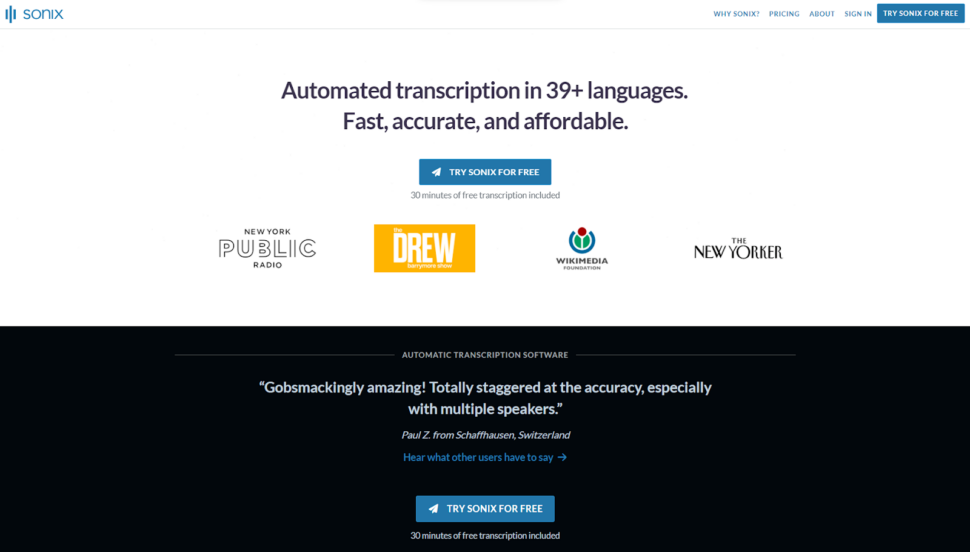
Sonix is a top choice for transcribing interviews due to its accurate and affordable transcription services. The platform supports over 39 languages and can transcribe several hours of content in just a few minutes with over 99% accuracy.
Sonix’s user-friendly interface and intuitive platform streamline the transcription process, allowing you to quickly upload your audio or video files and receive accurate transcriptions in a matter of minutes.
The software also offers a free trial with no credit card required, giving you the opportunity to evaluate the service’s suitability for your specific needs.
Why Sonix Is the Best Choice for Transcribing Interviews
- Near-Perfect Accuracy: Sonix consistently achieves transcription and translation accuracies of up to 99%. While we recommend a post-transcription review for optimal results, Sonix’s advanced AI technology ensures minimal errors, significantly reducing the time required to edit your content.
- Powerful Tools and Features: Sonix offers a range of powerful tools and features designed to make transcribing your interviews simple. With Sonix, you can easily organize, edit, and collaborate on your transcripts, ensuring a smooth and efficient workflow.
- Advanced Security: Sonix’s advanced security features offer bank-level encryption and security protocols to keep your confidential interviews safe. Sonix’s security features include SOC 2 Type 2 compliance, data transfer encryption, storage encryption, network protection, 2FA, and 24/7 security monitoring.
- Customizable Settings: Sonix allows you to customize various settings to suit your preferences, such as speaker labels, timestamp formats, and export options. This flexibility enables you to tailor the transcription process to your specific requirements, saving you time and effort in the long run.
- Cost-effective Pricing: With competitive pay-as-you-go pricing and flexible subscription plans, Sonix ensures that you can access high-quality transcription services at extremely affordable prices.
Interested in trying out Sonix’s 99% accuracy in your interviews? Sign up today for a 30-minute free trial. No credit card required.
2. Otter.ai
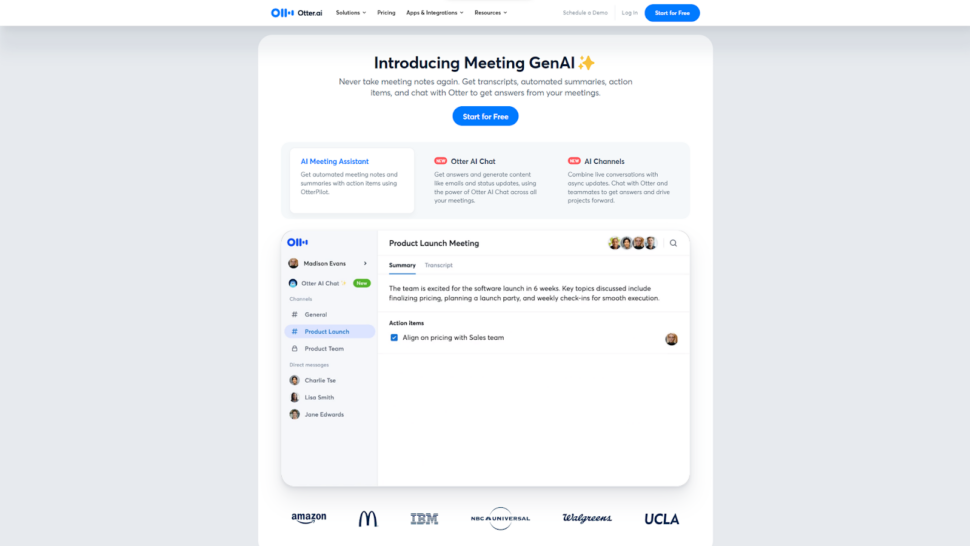
Otter.ai is another reliable transcription software for interviews, particularly if you’re looking to try out the tool before making the full purchase.
While Otter is a great tool for real-time transcription, its main drawback is the language support. Right now, Otter is only able to transcribe content in English. Furthermore, Otter’s accuracy tops out at 85%. While Otter’s suite of services is impressive, it does come at a compromise of accuracy.
Here are the core features of Otter AI.
- User-friendly Interface: Otter.ai has a clean, intuitive interface that makes navigating the platform and managing your transcriptions much easier. You can easily upload files, organize your transcripts, and collaborate with team members, all within a single, user-friendly dashboard.
- Real-time Transcription: One of Otter.ai’s standout features is its ability to provide real-time transcriptions during live interviews or meetings. This feature allows you to follow along with the conversation, take notes, and highlight important points as they happen, saving you valuable time and effort in the post-interview process.
- Speaker Identification: Otter.ai’s advanced speaker identification technology can accurately distinguish between multiple speakers in an interview, making it easier for you to attribute quotes and insights to the correct individuals. This feature is particularly useful for panel interviews.
3. Rev

Rev is another capable choice for transcribing interviews, particularly if you want to choose between human-generated and AI-powered transcriptions. With Rev, you can access both services at competitive rates, ensuring that you get the level of accuracy and turnaround time that best suits your needs and budget.
While Rev is a commendable tool, the company has shifted most of its focus to the human transcription industry. Their AI tool is still competent, however, it does not receive frequent updates and is prone to make mistakes.
Here are some of the main selling points of Rev AI.
- Flexible Transcription Options: Rev offers the unique advantage of allowing you to select either human transcriptionists or machine-generated transcriptions for your interview files. This flexibility enables you to prioritize accuracy or cost-effectiveness, depending on your specific requirements.
- Efficient Collaboration Tools: Rev provides a user-friendly, web-based platform that facilitates seamless collaboration among team members. You can easily share files, assign tasks, and communicate with your colleagues within the platform, streamlining your transcription workflow and ensuring everyone stays on the same page throughout the process.
- Collaboration Tools: Rev offers robust collaboration features, enabling teams to work together seamlessly on transcription projects. Users can easily share, comment, and edit transcripts, ensuring efficient communication and enhanced project management.
4. TranscribeMe

TranscribeMe is another affordable option for teams looking to transcribe their interview data. The platform offers both automated and human-generated transcriptions, giving you the flexibility to choose the service that best fits your needs and budget. Other than that, TranscribeMe also optimizes your workflow by providing fully customizable packages that can be tweaked to suit your use case optimally.
Some main aspects of TranscribeMe’s platform are listed below.
- Specialized Services: TranscribeMe provides transcription and translation services tailored to specific industries, such as legal, medical, and academic fields. This specialization ensures that your transcripts are accurate and adhere to the terminology and conventions of your niche.
- Multiple Language Support: With support for over 100 languages, TranscribeMe is an excellent choice for teams conducting interviews with diverse populations or working on international projects. The platform’s global network of transcribers and translators ensures that your content is accurately transcribed and translated, regardless of the language.
- Verbatim and Non-verbatim Options: TranscribeMe allows you to choose between verbatim and non-verbatim transcriptions, depending on your requirements. Verbatim transcriptions include all utterances, filler words, and non-verbal sounds, providing a comprehensive record of the interview. Non-verbatim transcriptions, on the other hand, focus on the main content and ideas, making them easier to read and analyze.
5. GoTranscript
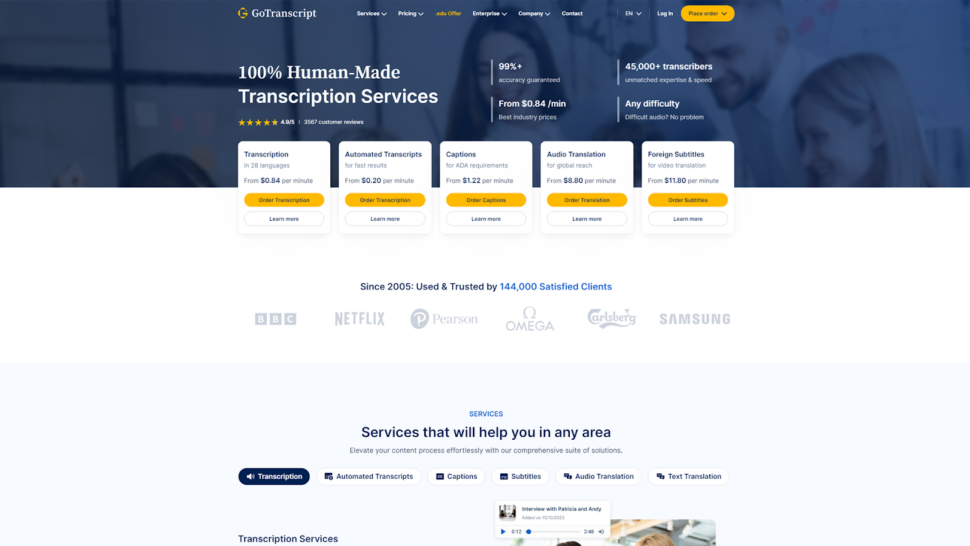
GoTranscript is a popular choice for its accurate, affordable, and human-generated transcriptions. The platform boasts a user-friendly interface and a team of experienced transcribers who deliver high-quality results.
GoTranscript also offers its own transcription API. This API can be effortlessly integrated into your custom software so your team can generate transcripts without switching to a different tool.
Here are the primary reasons for choosing GoTranscript as your transcription software.
- Specialized Transcribers: GoTranscript offers transcription services for various industries, including legal, medical, and academic fields. The platform assigns your interview files to transcribers with relevant expertise, ensuring that your transcripts are accurate and well-versed in industry-specific terminology.
- Timestamping and Speaker Identification: GoTranscript provides timestamping and speaker identification options, making navigating and analyzing your interview transcripts easier. These features are particularly useful when working with long interviews or focus group discussions, as they allow you to locate specific sections or attribute quotes to individual participants quickly.
- Collaborative Tools: The platform offers a range of collaborative tools, such as the ability to share files, leave comments, and track progress. These features streamline the transcription process and facilitate seamless communication between you and your team members, ensuring that everyone stays on the same page throughout the project.
6. Scribie
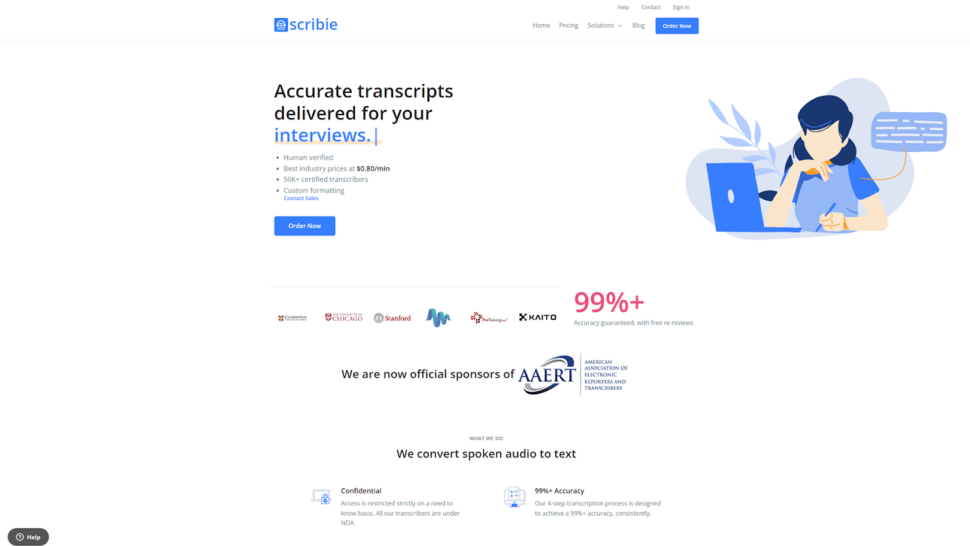
Scribie is a cost-effective and user-friendly transcription platform that delivers accurate results for individuals conducting interviews. The service offers both automated and human-generated transcriptions, providing you with the flexibility to choose the option that best suits your needs and budget.
Scribie is an extremely versatile software that supports various use cases, such as podcasts, dissertations, marketing calls, lectures, seminars, and court recordings. It can even transcribe sermons.
Here are the core reasons to pick Scribie for your transcription software.
- Affordable Pricing: Scribie’s competitive pricing makes it an attractive choice for startups working with limited funds. The platform offers a range of pricing options based on turnaround time and transcription type, allowing you to select the most cost-effective solution for your project.
- Easy-to-use Online Editor: Scribie’s intuitive online editor makes it simple to review, edit, and annotate your interview transcripts. The platform’s user-friendly interface allows you to navigate through your files effortlessly, making the transcription process more efficient and enjoyable.
- Data Security and Confidentiality: Scribie prioritizes the security and confidentiality of your interview data, employing strict measures to protect your files and ensure that only authorized individuals have access to your transcripts. This commitment to data protection gives you peace of mind, knowing that your sensitive information is safe and secure.
7. Trint
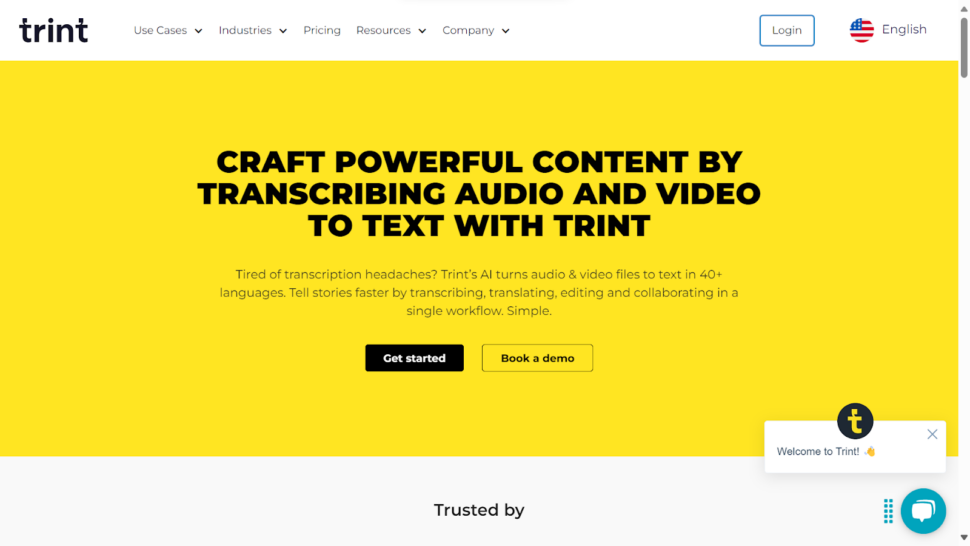
Trint is a powerful, web-based transcription platform designed with media professionals in mind. Its AI-powered technology quickly and accurately converts your audio and video files into text, making it an ideal choice for journalists, podcasters, and content creators.
Trint is a great platform if you’re conducting interviews in a journalistic manner. However, if you’re not in that industry, Trint might not be versatile enough for your use case.
Here are the main advantages of selecting Trint as your transcription tool.
- Collaborative Editing Tools: Trint’s user-friendly editor allows you to easily review, edit, and annotate your transcripts. You can also collaborate with your team in real-time, ensuring that everyone stays on the same page throughout the transcription process.
- Seamless Integration with Video Editing Software: Trint integrates with popular video editing tools like Adobe Premiere, enabling you to effortlessly import your transcripts and captions into your projects. This integration streamlines your workflow and saves you valuable time in the post-production process.
- Secure and Confidential: Trint takes data security seriously, employing ISO-certified measures to protect your files and transcripts. You can trust that your sensitive interview information is safe and secure when using Trint’s transcription services.
8. Temi
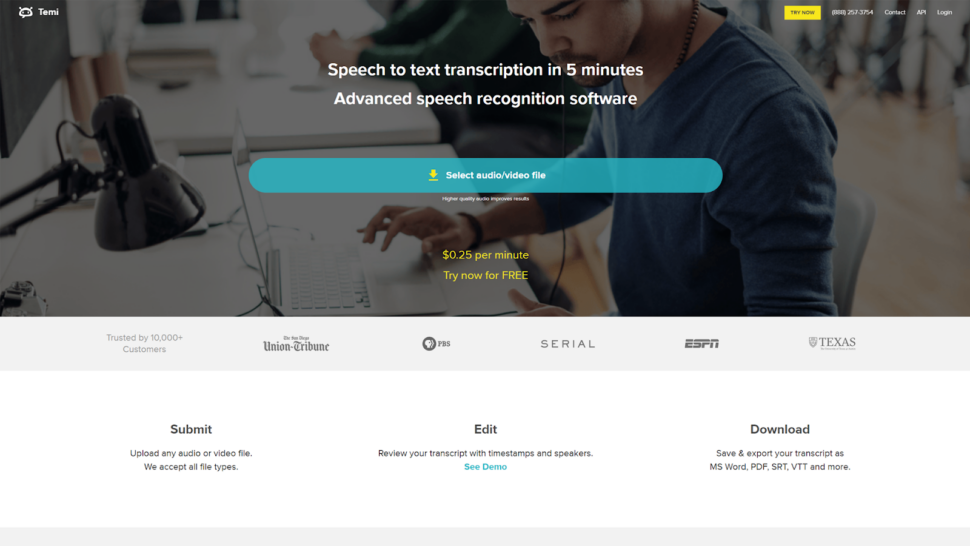
Temi is a fast and affordable transcription service that delivers interview transcripts within five minutes. Its AI-powered technology and user-friendly interface make it an attractive option for interviewers who need quick turnaround times without compromising on quality.
However, one drawback here is the price. Temi charges $0.25 per minute or $15 an hour. While this might not seem significant for one-off transcriptions, if you’re choosing a tool for frequent use, Temi can be costly. Furthermore, their platform only supports transcription in English. If you conduct interviews in other languages, you’ll most likely have to look for another tool.
With that said, here are some features of Temi that somewhat justify the price tag.
- Custom Timestamps and Speaker Identification: Temi allows you to add custom timestamps and speaker labels to your transcripts, making navigating and analyzing your interview data easier. These features are particularly useful when working with long interviews or multiple participants.
- Multiple Export Options: With Temi, you can export your transcripts in various formats, including MS Word, PDF, SRT, and more. This flexibility ensures that you can easily incorporate your transcripts into your existing workflow and share them with colleagues or clients.
- Rev’s API Usage: Temi has used Rev’s API for more than ten years on their backend. While the quality of transcripts will be the same as what you’ll get from Rev, the team at Temi has optimized the UI and user experience to be more streamlined.
9. Descript
Descript is an all-in-one audio and video editing platform that combines transcription, screen recording, podcast production, and AI-powered tools in a single workspace. Users can edit media by editing the transcript, making content creation faster and more intuitive.
Key features include Overdub (AI voice cloning), filler word removal, multitrack editing, and automatic transcription. Descript is especially popular among content creators, educators, and marketers looking for a streamlined way to produce, edit, and publish multimedia content with minimal technical effort.
- Text-Based Audio Editing: Descript’s primary selling point is its ability to let you edit audio by editing text. Delete a word in the transcript, and it disappears from the audio too. While innovative, this feature isn’t relevant for most interview transcription needs where preserving the original audio is important.
- Limited Accuracy: Despite its innovative approach, Descript’s transcription accuracy (around 95% for clear English audio) falls short of leaders like Sonix. Performance decreases noticeably with accented speakers or background noise.
- Restricted Language Support: The platform primarily supports English, with very limited capabilities in other languages, making it unsuitable for international research or multilingual interviews.
- Resource-Intensive: Users report that Descript requires significant computing power and can run slowly on older machines, potentially causing frustration during time-sensitive transcription work.
- Workflow Integration: While it offers a unique all-in-one editing environment, Descript doesn’t integrate as seamlessly with other productivity tools compared to dedicated transcription platforms.
10. Jamie
Jamie is an AI-powered personal meeting assistant that provides detailed meeting summaries, action items, and follow-up content without using intrusive bots. It works with all video conferencing platforms, as well as in-person meetings, offering a privacy-first, GDPR-compliant experience.
Jamie supports 20+ languages, uses advanced AI like GPT-4 and Claude, and includes features like speaker recognition, note templates, and searchable meeting history. Ideal for professionals who want automated, non-disruptive meeting documentation across any platform or setting.
- Meeting-Focused Features: Jamie promotes its “Interview Intelligence” capabilities including sentiment analysis and topic detection, but in testing, these features often produce generic results that provide limited practical value.
- Inconsistent Accuracy: The platform’s transcription accuracy varies widely depending on audio quality and speaker accents, averaging around 90% for optimal conditions but dropping significantly with multiple speakers or background noise.
- Limited Integration Options: While Jamie offers CRM connections, its overall integration ecosystem is relatively limited compared to more established competitors.
- Evolving Platform: As a newer service, users report occasional stability issues and interface changes that can disrupt established workflows.
- Pricing Structure: Jamie’s subscription model starts at $29/month, which may be excessive for occasional users who would benefit more from pay-as-you-go options offered by competitors.
11. Happy Scribe
Happy Scribe is a transcription and subtitling platform offering both AI-generated and human-made services. It supports over 120 languages and dialects, making it suitable for international content creators, researchers, and media teams.
Users can transcribe audio and video, generate subtitles, and translate content directly within an interactive online editor. While AI transcriptions offer faster turnaround, human services are available for higher accuracy.
Happy Scribe also provides features like speaker identification, custom timestamps, and subtitle formatting for a variety of professional use cases.
- Subtitle Emphasis: While Happy Scribe claims to support over 120 languages, its primary strength is in subtitling rather than accurate interview transcription. This focus means some interview-specific features are underdeveloped.
- Accuracy Challenges: Happy Scribe’s automated transcription typically achieves only about 85% accuracy, requiring significant manual correction for professional use.
- Pricing Concerns: At approximately $12 per hour of audio, Happy Scribe is relatively expensive for its accuracy level, especially compared to competitors offering better results at similar price points.
- Limited Editing Tools: The transcript editor lacks some advanced features found in dedicated transcription platforms, making post-processing more time-consuming.
- Customer Support Issues: Some users report delayed responses to technical issues, which can be problematic when working with time-sensitive interview transcriptions.
How to Transcribe Interviews
Transcribing interviews effectively requires a systematic approach to ensure accuracy and efficiency. Here’s a step-by-step guide:
1. Prepare Your Audio Recording
Quality preparation makes all the difference in transcription accuracy. Use a professional-grade microphone or recording device whenever possible, and conduct interviews in quiet environments to minimize background noise. Before any important interview, always test your recording setup to ensure proper functioning and optimal audio levels.
2. Choose Your Transcription Method
You have three main options for transcription. Automatic transcription involves uploading your audio file to software like Sonix, which uses AI to generate a transcript quickly. Manual transcription, while time-consuming, offers complete control and is sometimes necessary for very poor audio quality or heavy accents. Many professionals opt for a hybrid approach; using AI for the initial draft, then manually editing for accuracy.
3. Upload Your Audio File
Most modern transcription platforms support common audio formats including MP3, WAV, and M4A. For lengthy interviews exceeding platform limits, you may need to split files into smaller segments. Some advanced services offer direct recording through their interface, streamlining the process by eliminating separate recording steps.
4. Process the Transcription
During automatic transcription, the software analyzes the audio patterns and converts them to text. Processing time varies significantly depending on file length and the service you’re using. The major advantage of today’s AI-powered solutions is their speed — many services deliver complete transcripts in minutes rather than the hours required for manual transcription.
5. Edit and Refine
Review is essential even with high-accuracy services. Carefully examine the generated transcript, paying special attention to technical terms, proper names, and sections with multiple speakers. Add proper punctuation and formatting to improve readability, and clearly identify each speaker if the software hasn’t done so automatically. For research interviews, consider adding timestamps at important points for easy reference.
6. Format the Transcript
Choose the appropriate transcription style for your needs. Verbatim transcripts include every utterance, including filler words and false starts, while clean transcripts remove these elements for improved readability.
Include headers with essential information like interview date, participant names, and subject. Format speaker names consistently throughout, and use paragraph breaks to improve readability and content flow.
Export your completed transcript in your preferred format – DOC for editing, PDF for sharing, or TXT for plaintext applications. For collaborative projects, consider sharing with participants for review and accuracy confirmation. Always store interview transcripts securely with appropriate access permissions to protect sensitive information.
With tools like Sonix, you can automate most of this process, reducing a task that traditionally took hours to just minutes while maintaining exceptional accuracy.
What You Should Know About AI vs Human Transcription
Now that you know the top platforms in the market, you might be considering the difference between AI and human transcription. While human transcription might seem like the better option, there are various advantages of going the AI route. Here’s what you need to know.
AI Transcription Advantages
The speed of AI transcription is perhaps its most compelling advantage: processing hours of audio in minutes rather than the days it might take for human transcription. This time efficiency translates directly to cost-effectiveness, with AI services generally charging a fraction of human transcription rates.
AI systems offer consistency throughout documents, applying the same rules and formatting from beginning to end. They also provide complete privacy, as no human listens to potentially sensitive conversations. For urgent projects, the 24/7 availability of AI services eliminates waiting for business hours or dealing with transcriber availability.
Human Transcription Advantages
Where AI still struggles, human transcribers excel. Challenging audio with background noise, heavy accents, or technical jargon is handled much more accurately by experienced human transcribers who can use context clues to decipher difficult passages.
Humans bring contextual understanding that machines cannot match, capturing nuanced meanings and implied information. They can customize formatting to meet specific requirements, and identify non-verbal communication elements like laughter, significant pauses, or emotional tones that AI might miss.
Best Practices for Optimal Results
For AI transcription, focus on optimizing your inputs. Ensure clear audio quality by recording in quiet environments with good equipment. Encourage speakers to articulate clearly and avoid talking over each other. Take advantage of platform-specific features like custom vocabularies for industry terminology, and always plan time to review and edit AI-generated transcripts.
When using human transcription services, provide clear instructions about your formatting preferences and any specialized terminology. Allow reasonable turnaround times instead of rushing the process, and share contextual information when dealing with specialized topics or industry-specific content.
Many professionals find that a hybrid approach yields the best results. Use AI for the initial draft to save time and money, then have human reviewers correct errors and refine the transcript. This method combines the speed and cost benefits of AI with the accuracy and nuance of human review.
The quality gap between AI and human transcription continues to narrow, with advanced AI services like Sonix achieving up to 99% accuracy in optimal conditions.
For most interview transcription needs, AI services offer the best balance of speed, accuracy, and cost-effectiveness, particularly when followed by a quick human review.
How to Choose the Right Transcription Software for Your Interviews?
When selecting the best transcription software for your interviews, it’s essential to carefully evaluate your unique requirements and compare the features and benefits of various platforms.
Usage Volumes
First, assess the volume of transcription work you anticipate and determine your budget. Some software offers cost-effective subscription plans or pay-as-you-go pricing, making them suitable for varying transcription needs. If you have a large volume of interviews to transcribe, look for a platform with competitive pricing and the ability to handle bulk uploads.
Accuracy Levels
Next, consider the accuracy levels offered by each platform and their support for multiple languages. High accuracy rates ensure that your interview transcripts are precise and reliable, saving you time and effort in the editing process. If you conduct interviews in different languages, choose software that supports the languages relevant to your work.
Security Protocols
When dealing with sensitive interview data, it’s crucial to choose a transcription platform that prioritizes security and confidentiality. Opt for software that employs industry-standard encryption and secure servers to protect your files and transcripts. Ensure that the platform you select has strict data protection measures in place to safeguard your information.
Look for Free Trials
Many transcription platforms offer free trials or demo versions, allowing you to test the software before committing to a subscription. Take advantage of these opportunities to explore the features, assess the accuracy of the transcriptions, and determine whether the platform meets your specific needs. Hands-on experience with the software can help you make an informed decision and choose the best transcription tool for your interviews.
Interview Transcription Software Comparison Table
| Tool | Accuracy | AI Features | Languages | Collaboration & Integrations | Pricing |
| Sonix | Up to 99% | Summaries, sentiment, topic detection, custom prompts | 53+ with strong accuracy | Advanced collaboration + integrations (Zoom, Adobe, Drive) | $10/hr pay-as-you-go; $5/hr with subscription |
| Otter.ai | ~83–85% | Live transcription, basic summary | English only | Team tools, calendar sync | Free tier; paid plans start at $16.99/month |
| Rev | 90% | None | Limited | Manual sharing, no real-time collaboration | $0.25/min or $15/hour |
| TranscribeMe | ~90% | No post-transcription AI features | Several, accuracy varies | Limited editor; no collaboration | $0.07/min or $4.2/hour |
| GoTranscript | 95-98% (human) | None (human-based) | 50+ | Basic file sharing | Starting at $0.90/min |
| Scribie | 98% | AI options upcoming | Limited | Simple editor, minimal collaboration | $0.80/min |
| Trint | ~90–95% | Summaries, translation, limited AI tools | 40+ | Good integrations (Adobe, Drive) | From $80/month |
| Temi | ~85–90% | None | English only | Basic editor, no integrations | $0.25/min or $15/hour |
| Descript | ~95% | Editing via text, overdub, filler removal | English, limited support | Built-in media editor | Free tier; Creator plan $19/month |
| Jamie | ~90% | Meeting insights, action items, CRM integration | English, limited others | Strong meeting integrations | Plans starting at $25/month |
| Happy Scribe | ~85% | Subtitling, translation | 120+ | Subtitle-focused workflow tools | $12 per hour |
Final Thoughts: What Is the Best Transcription Software for Interviews?
Transcribing your interview content is crucial for accuracy, accessibility, and ease of reference. Accurate transcripts allow for detailed analysis, effective communication, and reliable documentation, enhancing the value of your content.
Sonix emerges as the best tool for this task, offering transcription services in over 39 languages with an impressive 99% accuracy. Its user-friendly platform enables quick uploads and rapid transcriptions, making the process efficient. Sonix’s powerful features, such as advanced AI technology and customizable settings, ensure minimal errors and tailored transcriptions. Additionally, its advanced security measures guarantee the safety of your confidential interviews.
With competitive pricing and flexible subscription plans, Sonix provides an affordable solution without compromising on quality. Whether you need to transcribe a single interview or manage multiple projects, Sonix stands out as the premier choice for accurate and efficient transcription.
Try Sonix’s free trial today and get 30-minutes of free transcription. No credit card required.
Frequently Asked Questions About Transcription Software for Interviews
What Is the Best Format for Interview Transcripts?
The best format for interview transcripts can be either verbatim or non-verbatim, depending on your use case. Verbatim transcripts capture every word, including fillers and pauses, ideal for legal or research purposes. Non-verbatim transcripts omit non-essential words and focus on the main content, making them clearer and more concise for general use.
What Is the Best Way to Transcribe an Interview?
For 100% accuracy, manual transcription is best but slow. Alternatively, you can use AI transcription tools for faster results with good accuracy. Human transcription services offer high accuracy but are often pricey and slow. Choosing the method depends on your accuracy needs, budget, and time constraints.
What Is the Most Accurate Transcription Software?
Sonix is known for its high accuracy, achieving up to 99% in transcription quality. It uses advanced AI technology to deliver precise and efficient transcriptions. Sonix is favored for its reliability, user-friendly interface, and support for multiple languages, making it an excellent choice for professional transcription needs.

